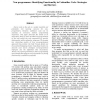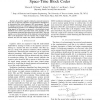436 search results - page 2 / 88 » On two variations of identifying codes |
DATE
2003
IEEE
13 years 10 months ago
2003
IEEE
In this article we propose a high speed and highly testable parallel two-rail code checker, which features a compact structure and is Totally-Self-Checking or Strongly Code-Disjoi...
VL
2009
IEEE
13 years 12 months ago
2009
IEEE
Source code on the web is a widely available and potentially rich learning resource for nonprogrammers. However, unfamiliar code can be daunting to end-users without programming e...
CORR
2010
Springer
13 years 5 months ago
2010
Springer
Given a graph G, an identifying code D V (G) is a vertex set such that for any two distinct vertices v1, v2 V (G), the sets N[v1] D and N[v2] D are distinct and nonempty (here...
ESORICS
2011
Springer
12 years 4 months ago
2011
Springer
Program authorship attribution—identifying a programmer based on stylistic characteristics of code—has practical implications for detecting software theft, digital forensics, a...
GLOBECOM
2008
IEEE
13 years 11 months ago
2008
IEEE
—Research in cognitive radios has renewed interest in tools, such as spectrum estimation and modulation identification, to characterize the radio frequency (RF) environment. The...


